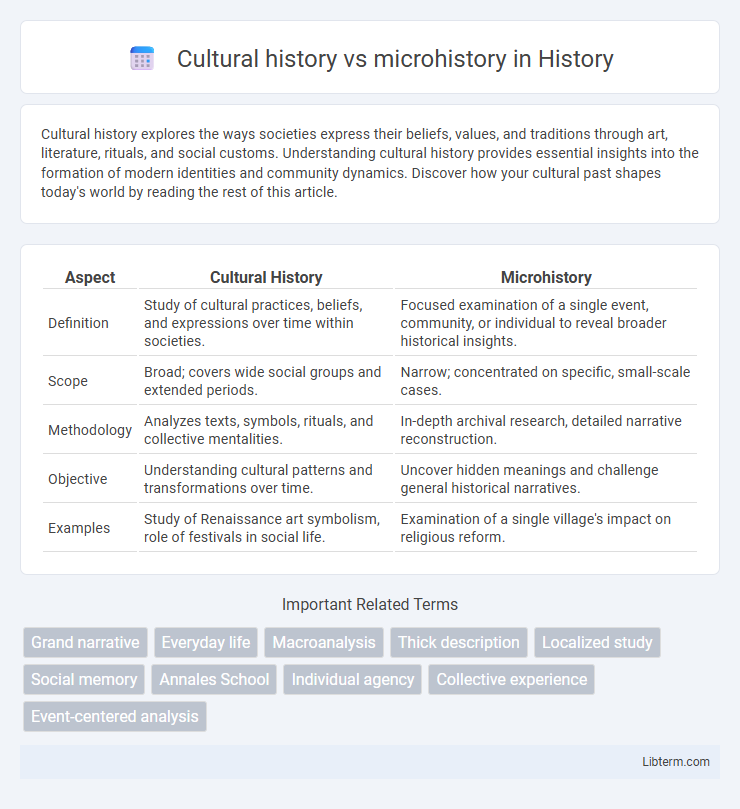Cultural history explores the ways societies express their beliefs, values, and traditions through art, literature, rituals, and social customs. Understanding cultural history provides essential insights into the formation of modern identities and community dynamics. Discover how your cultural past shapes today's world by reading the rest of this article.
Table of Comparison
| Aspect | Cultural History | Microhistory |
|---|---|---|
| Definition | Study of cultural practices, beliefs, and expressions over time within societies. | Focused examination of a single event, community, or individual to reveal broader historical insights. |
| Scope | Broad; covers wide social groups and extended periods. | Narrow; concentrated on specific, small-scale cases. |
| Methodology | Analyzes texts, symbols, rituals, and collective mentalities. | In-depth archival research, detailed narrative reconstruction. |
| Objective | Understanding cultural patterns and transformations over time. | Uncover hidden meanings and challenge general historical narratives. |
| Examples | Study of Renaissance art symbolism, role of festivals in social life. | Examination of a single village's impact on religious reform. |
Defining Cultural History: Scope and Significance
Cultural history examines the beliefs, practices, and symbols that shape societies over long periods, emphasizing collective mentalities and social contexts. It integrates diverse sources such as art, literature, rituals, and everyday life to understand cultural representations and identities. Unlike microhistory, which focuses narrowly on individual events or communities to reveal broader historical insights, cultural history prioritizes overarching cultural patterns and their transformations.
What is Microhistory? Origins and Evolution
Microhistory is an approach in historiography that emerged in the 1970s, emphasizing the detailed study of a small unit, such as an individual, community, or event, to uncover broader social and cultural dynamics. Originating from historians like Carlo Ginzburg and Giovanni Levi, it challenges traditional grand narratives by focusing on the everyday lives and local experiences often neglected in mainstream cultural history. Microhistory evolved as a response to cultural history's broad scope, offering a bottom-up perspective that highlights complexity and nuances in historical interpretation.
Methodologies: Comparative Approaches in Analysis
Cultural history employs broad comparative methodologies that analyze large-scale social patterns and collective mentalities across different societies and time periods, emphasizing symbolic systems, rituals, and cultural expressions. Microhistory uses intensive, localized case studies to uncover detailed narratives of individuals or communities, leveraging thick description and fine-grained archival research to reveal broader societal dynamics through in-depth analysis. Both methodologies intersect by contextualizing micro-level insights within macro cultural frameworks, enabling a nuanced comparative approach that connects singular events to overarching historical processes.
Scale and Focus: Macro versus Micro Perspectives
Cultural history examines broad societal trends and large-scale cultural phenomena, emphasizing macro perspectives that analyze collective experiences across vast populations and extended time periods. Microhistory concentrates on detailed studies of specific individuals, communities, or events, offering a micro perspective that uncovers nuanced insights often overlooked in larger narratives. The contrasting scales between cultural history's expansive scope and microhistory's focused lens highlight the complementary approaches to understanding historical complexity.
Sources and Evidence: Types and Usage
Cultural history relies heavily on diverse sources such as literature, art, music, and oral traditions to understand broad societal values and practices, emphasizing symbolic and representational evidence. Microhistory focuses on detailed archival documents, legal records, personal letters, and diaries to reconstruct specific individual or community experiences within a limited context. Both approaches utilize primary sources critically but vary in scale and specificity, with cultural history analyzing collective cultural expressions and microhistory prioritizing granular, localized evidence.
Narratives: Storytelling in Cultural History and Microhistory
Narratives in cultural history emphasize broad thematic storytelling that explores collective experiences and societal transformations over time. Microhistory focuses on detailed, intimate storytelling centered on specific individuals or events, revealing larger cultural patterns through granular analysis. Both approaches utilize narrative techniques to uncover meaning, but cultural history seeks generalizable trends while microhistory highlights unique, localized stories.
Thematic Depth: Everyday Life versus Grand Trends
Cultural history delves into broad societal patterns, exploring grand trends and collective mentalities that shape civilizations over time. Microhistory concentrates on thematic depth by examining everyday life and individual experiences to illuminate larger historical processes through detailed case studies. This approach reveals nuanced social dynamics often overlooked by conventional cultural history narratives.
Influence on Historiography: Academic Contributions
Cultural history reshaped historiography by emphasizing the symbolic meanings, mentalities, and everyday practices of past societies, fostering interdisciplinary approaches incorporating anthropology and sociology. Microhistory challenged grand narratives by uncovering detailed, localized experiences that reveal broader socio-cultural dynamics, pushing historians to reconsider sources and scale. Both contributed academically by expanding methodologies, enriching historical interpretation, and promoting nuanced understandings of human behavior across time.
Critiques and Controversies in Both Fields
Cultural history faces critiques for its broad generalizations and potential neglect of individual experiences, while microhistory is often criticized for its narrow focus that may not represent larger social patterns. Debates persist over cultural history's tendency to impose overarching narratives versus microhistory's alleged anecdotalism and limited contextual scope. Both fields grapple with balancing depth and breadth, challenging historians to integrate detailed local studies with wider cultural phenomena without sacrificing analytical rigor.
Future Directions: Integrating Microhistory with Cultural History
Future directions in historical research emphasize integrating microhistory with cultural history to foster a nuanced understanding of individual experiences within broader cultural contexts. This approach leverages detailed case studies from microhistory to enrich cultural history's analysis of societal norms, practices, and collective memory. Advancements in digital humanities tools facilitate this integration by enabling large-scale data analysis alongside intimate narrative reconstructions.
Cultural history Infographic

 libterm.com
libterm.com